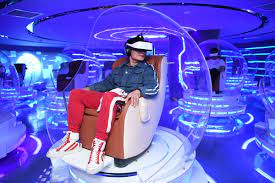VR Entertainment
It is important to remember that Virtual Reality began as a theatre term, as that helps explain why it was seemingly only valued as a means of entertainment for so many years. Most of the major advancements in the 20th century came in the field of video games, and it only became widespread with the release of the Oculus Rift in the 2010s. It has not just been used for video games though. In 1992, Nicole Stenger created Angels, a fully interactive and immersive movie, the first of its kind, with a headset and a dataglove. Now, there are countless VR cinematic experiences you can plug into, from indie features uploaded directly to youtube, to major franchise titles like Star Wars, Marvel, and Hunger Games.
 |
|---|
| Nicole Stenger |
From an artistic perspective, this is incredible, it opens up a whole world of creative possibilities. There are so many different storytelling opportunities to explore. Video game developers have already began to blur the lines between what can be considered a game and what is a film, and VR adds a whole other level to that. How is an immersive film that you can look around and explore different from a video game? Where does one draw the line?
That is not what this exploration is about, though. While a large amount of VR experiences are somewhat interactive, I will be removing that element for the sake of more appropriately comparing it to tradition cinema. Yes, there is also interactive traditional cinema, but it is a much smaller amount of it. When one experiences a movie in a theatre, you get the experience of seeing it alongside people. It is a collective experience, you get to all jump at the same time at scary scenes, you get to cry, laugh, and cringe together. Experiencing something through a VR headset is entirely different, you may have more freedom to look around your environment, but it is all about you, the screen is literally only available to your eyes.
The cinematic experience has been growing more individualistic ever since the invention of the television. The public panicked over theatres going bankrupt because you could just watch something on your tv instead of going out, but it turned out that watching black and white television on a tiny box in your living room was not quite the same as a full-colour movie on the big screen. Then, the same thing happened with the invention of the VCR, but once again, people still wanted a specific, theatrical experience. Then, streaming came along and drove rental stores out of business, and once again we panicked about losing the theatre. Before, you would at least have to wait for a movie to come out on video, and would go to the theatre to see it first, but now the studios are making their own streaming platforms, and streaming platforms are making their own studios, they can just release things directly to your laptop.
 |
|---|
However, with each of these innovations; the television, the VCR, and the streaming service, there is still an opportunity for a social aspect to viewing. The family can gather around a television, or go out to blockbuster together, or scroll through Netflix for two hours trying to decide on something. With VR, it is entirely individual.
This isn’t necessarily a bad thing, there is certainly something to be said about the value of an individual experience, and there is definitely great art that has been made and will be continue to be made with this factor in mind. However, it is my hope that this becomes simply another medium for entertainment, and not the new dominant form. If there is value in the individual experience, there is certainly also value in the collective experience and seeing something together, of discussing it afterwards and sharing perspectives. Obviously, two people can still experience the same VR film separately and then discuss it afterwards, but that collective experience is lost.
